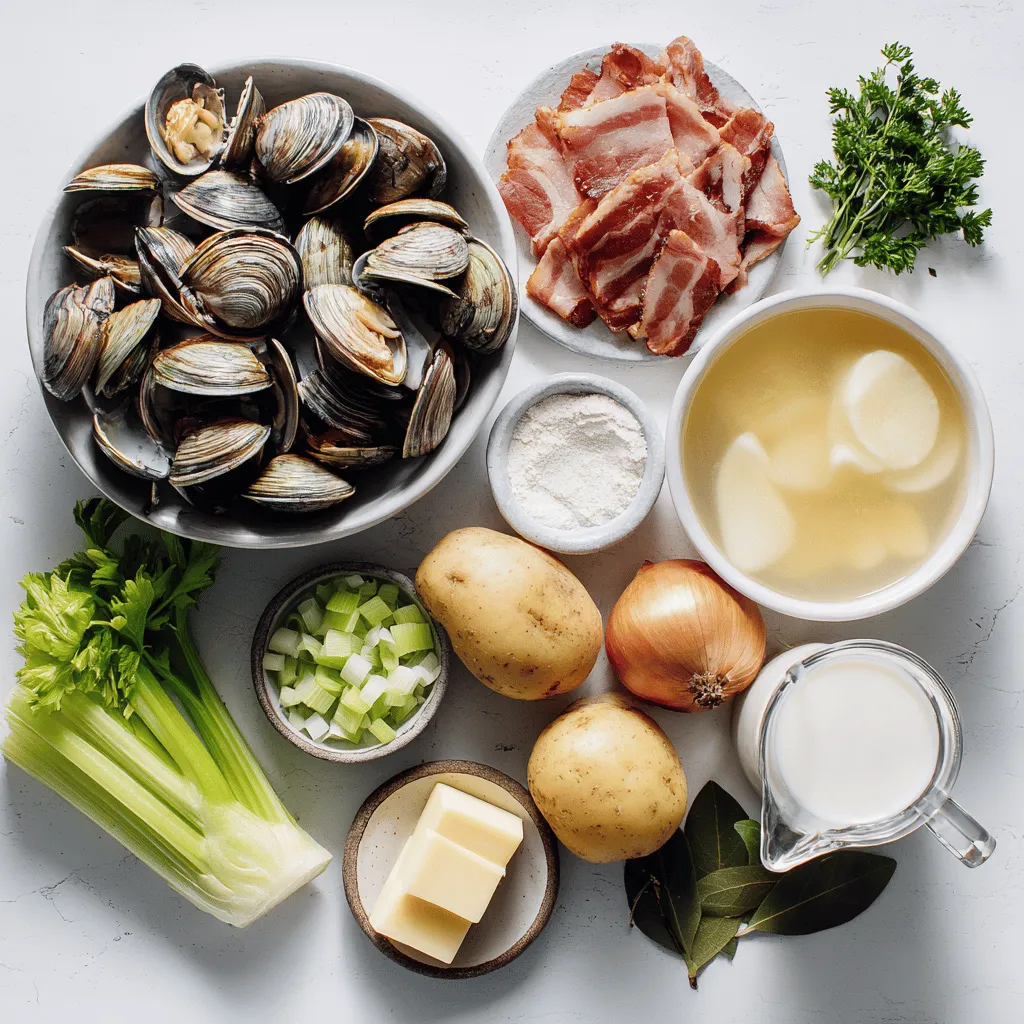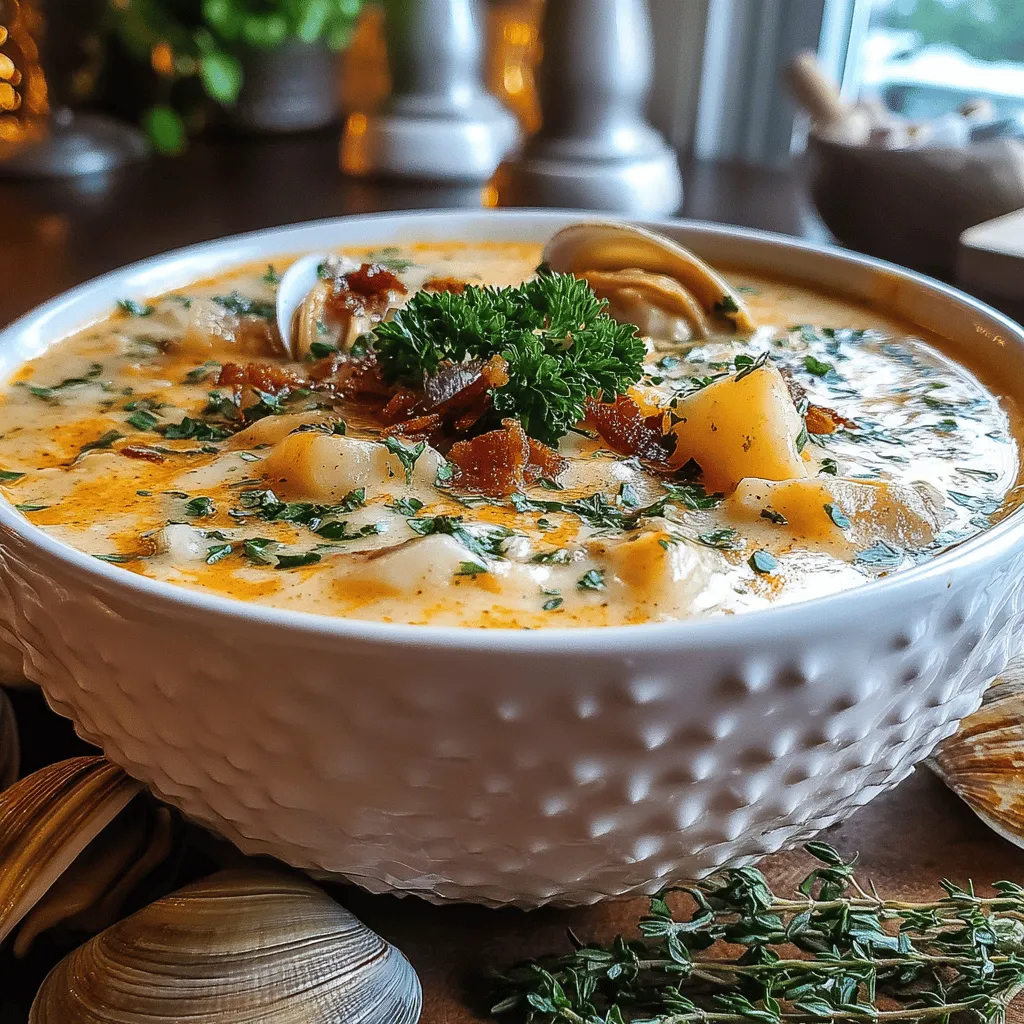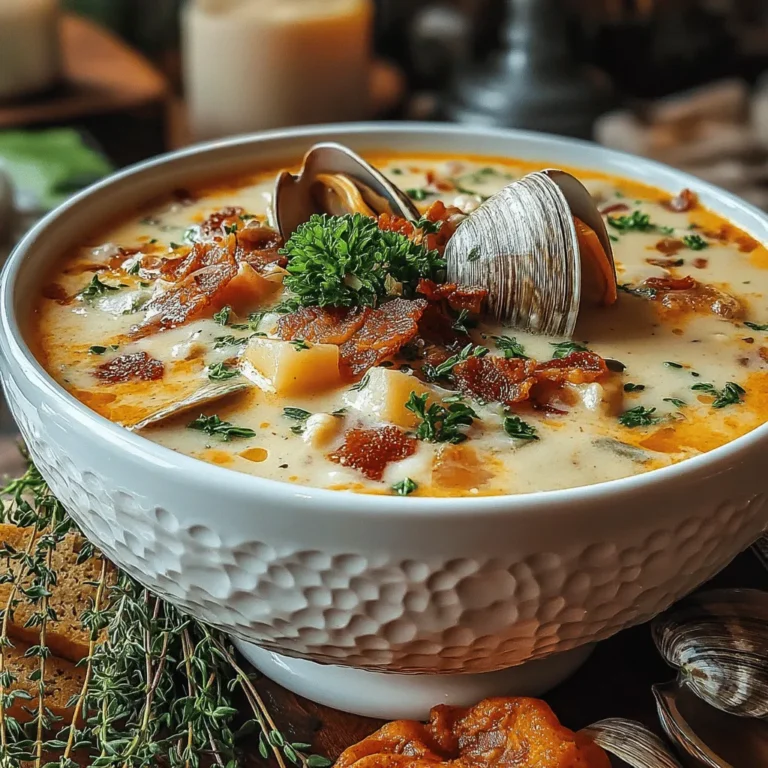Introduction
New England Clam Chowder is a beloved classic that evokes the essence of coastal dining. Its creamy texture and rich flavors have made it a staple in homes and restaurants alike, where it delivers a warm, comforting embrace with every spoonful. This dish is not just food; it is a representation of the culinary heritage that defines New England.
Comfort food plays a significant role in our culinary traditions, offering a sense of nostalgia and connection to our roots. In coastal New England, clam chowder stands out as a quintessential dish that brings together the flavors of the sea with the warmth of home cooking. Whether you choose to use fresh clams or canned, this recipe is designed to be accessible to all, making it an ideal choice for both novice and seasoned cooks.
Recipe Overview
– Total Time: 1 hour
– Servings: 6
– Difficulty: Medium
Ingredients
– 4 cups fresh clams, cleaned (or 2 cans of clams)
– 4 slices of bacon, chopped
– 1 medium onion, diced
– 2 stalks of celery, diced
– 2 medium potatoes, peeled and diced
– 2 cups clam juice or seafood stock
– 1 cup heavy cream
– 2 tablespoons butter
– Salt and pepper, to taste
– Fresh parsley, for garnish

Instructions
1. If using fresh clams, steam them in a pot with a little water until they open. Remove clams from shells and reserve the clam juice. Chop the clams and set aside.
2. In a large pot, cook the chopped bacon over medium heat until crispy. Remove bacon and drain on paper towels, leaving the rendered fat in the pot.
3. Add diced onions and celery to the pot and sauté until softened, about 5 minutes.
4. Add the diced potatoes to the pot, stirring to combine with the aromatics.
5. Pour in the clam juice or seafood stock, and bring to a simmer. Cook until the potatoes are tender, about 15-20 minutes.
6. Stir in the heavy cream, chopped clams, and cooked bacon. Season with salt and pepper to taste.
7. Simmer for an additional 5 minutes, then add butter and stir until melted.
8. Serve hot, garnished with fresh parsley.
The Heart of New England Cuisine: Understanding Clam Chowder
– Historical background of clam chowder in New England.
– Regional variations and their unique characteristics.
– The significance of fresh, local ingredients in this recipe.

Importance of Bacon Fat as a Flavor Base for the Chowder
Bacon fat serves as a pivotal flavor base for New England clam chowder, imparting a rich, smoky depth that enhances the overall taste. When rendered properly, bacon fat not only adds flavor but also provides a robust foundation for the dish. It complements the briny clams and creamy texture, creating a harmonious balance.
Tips for Achieving the Perfect Crispness
For the best results, choose thick-cut bacon and cook it over medium heat to render the fat slowly. This technique allows the bacon to become crispy without burning. Remember to reserve some of the bacon fat after cooking, as it will be essential for sautéing your aromatics and building the chowder’s flavor profile.
Sautéing Aromatics
Techniques for Sautéing Onions and Celery to Release Their Natural Sweetness
Sautéing onions and celery in the bacon fat helps to unlock their natural sweetness, which is crucial for a well-rounded chowder. Begin by adding the diced onions first, allowing them to soften and become translucent before introducing the celery. This method ensures that both vegetables develop their flavors fully and create a savory base for the chowder.
Explanation of Making a Roux and Its Role in Thickening the Chowder
A roux is a mixture of fat and flour that acts as a thickening agent for your chowder. Once your aromatics are sautéed, sprinkle in flour and cook for a couple of minutes to eliminate the raw flavor. Slowly whisk in clam juice to prevent lumps, creating a smooth and creamy consistency that binds the chowder together.
Building the Chowder
Importance of Whisking in Clam Juice to Prevent Lumps
When adding clam juice, whisk continuously to ensure that the roux integrates smoothly with the liquid. This step is vital for achieving a velvety chowder without any unwanted lumps. The whisking process helps to emulsify the ingredients, resulting in a cohesive and luxurious soup.
Timing for Adding Potatoes and the Significance of Simmering
Add diced potatoes after the clam juice has been incorporated and bring the mixture to a gentle simmer. Simmering allows the potatoes to soften and absorb the flavors of the chowder without becoming mushy. Timing is key; aim for tender potatoes that hold their shape while contributing to the chowder’s heartiness.
Incorporating Dairy
Discussion on Balancing Flavors with Heavy Cream and Milk
To achieve the classic creamy texture of New England clam chowder, it’s essential to balance heavy cream and milk. Heavy cream adds richness, while milk provides a lighter texture. Start by adding a small amount of each, tasting as you go, to ensure the chowder remains flavorful without being overly heavy.
Tips on How to Avoid Curdling
To prevent curdling, avoid boiling the chowder after adding dairy. Instead, maintain a gentle simmer. Additionally, temper the cream by gradually adding a small amount of the hot chowder into the cream before mixing it back into the pot. This technique helps to acclimate the temperature and reduces the risk of curdling.
Finishing Touches
How to Incorporate Clams and Bacon for the Best Texture and Flavor
Once the chowder has reached the desired consistency, it’s time to fold in the clams and crispy bacon. This step ensures the clams are warmed through without overcooking, which can lead to a rubbery texture. The combination of the tender clams and crunchy bacon adds the perfect finishing touch.
The Art of Seasoning to Taste
Seasoning your chowder is crucial for enhancing its flavors. Start with salt and pepper, then taste and adjust as needed. For added complexity, consider a dash of Worcestershire sauce or a sprinkle of fresh herbs like thyme or parsley just before serving.
Serving Suggestions: Elevating Your Chowder Experience
For an impressive presentation, serve your chowder in rustic bread bowls. This not only adds a charming touch but also allows diners to enjoy the bread as they finish their soup. Complement the chowder with toppings such as crispy bacon bits, fresh chives, or a sprinkle of paprika for a pop of color.
Complementary Toppings and Garnishes to Enhance Presentation
Enhance your chowder’s presentation with additional garnishes. A drizzle of olive oil or a dollop of crème fraîche can elevate the dish further. Oyster crackers are a classic accompaniment, providing a delightful crunch that contrasts beautifully with the creamy soup.
Suggestions for Sides Like Oyster Crackers for Added Texture
Serve your chowder alongside traditional sides like oyster crackers or a fresh garden salad. These sides not only add texture but also balance the richness of the chowder, making for a well-rounded meal.
Conclusion
New England clam chowder is a timeless comfort food that embodies warmth and tradition. Its rich flavors and creamy texture make it a staple in home cooking, perfect for family gatherings or cozy nights in. Embrace this classic recipe and create your own cherished memories, savoring each bowl as a celebration of comfort and culinary heritage.


